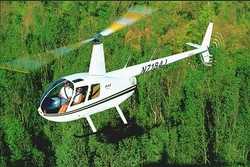R44 Became Entangled In Plastic Along With The Animal
Alaska is known for its heavy use of aircraft in innumerable
situations. But in this case, a ranch hand flying an R44 found
himself at the wrong end of what must have been a very bizarre
situation, with fatal results.

According to the NTSB's probable cause report, on June 19, 2010,
about 1700 Alaska daylight time, a Robinson R44 helicopter, N333DV,
sustained substantial damage when it collided with terrain about 62
miles southwest of Unalaska, Alaska. The helicopter was being
operated by the pilot as a visual flight rules (VFR)other work use
flight, in conjunction with a cattle ranch, under Title 14, CFR
Part 91, when the accident occurred. The solo commercial pilot died
in the accident. Visual meteorological conditions prevailed, and
company flight following procedures were in effect.
During a telephone conversation with the National Transportation
Safety Board (NTSB) investigator-in-charge on June 19, an official
for the cattle ranch said another pilot at the ranch told her the
helicopter pilot had just dropped off two employees for a cattle
count, and upon departure, the helicopter had "caught a skid," and
impacted terrain. The employees attempted to render aid to the
accident pilot, but she was told the pilot died. The employees
reported they did not think there were any problems with the
helicopter prior to the accident.

R44 File Photo
In a written statement provided to the NTSB IIC by one of the
ranch employees who witnessed the accident, the witness reported
that he and another employee were in the helicopter with the pilot,
surveying the ranch property, when they spotted a bull that had
become entangled in plastic wrapping material. He said he and the
other employee got out of the helicopter, and the pilot attempted
to herd the bull toward them so they could cut the plastic off. The
witness said the bull would not cooperate, and the pilot tried to
land on the trailing plastic so they could tackle the bull. The
witness also reported that the pilot tried to knock the bull down
with the helicopter. He said eventually the pilot got the
helicopter's right landing gear skid under the plastic and tried to
pick the bull up, but the plastic broke. He said the pilot hooked
the skid under the plastic again, but this time the plastic did not
break, and as the helicopter lifted the bull off the ground the
helicopter moved forward and to the right, and impacted the
ground.
Due to the remote location, the helicopter was not examined by
the NTSB.
A postmortem examination of the pilot was conducted under the
authority of the Alaska State Medical Examiner, 4500 South Boniface
Parkway, Anchorage, Alaska, on June 25, 2010. The examination
revealed the cause of death for the pilot was attributed to
multiple blunt force injuries.
The FAA's Civil Aeromedical Institute (CAMI) conducted a
toxicological examination on August 12, 2010, which detected
amounts of Ethanol, Methanol, and N-Propanol. The Ethanol in this
case was from sources other than consumption. Ibuprofen was
detected in the urine.
The National Transportation Safety Board determines the probable
cause of this accident to be the pilot's inappropriate low altitude
maneuvering, which resulted in a collision with terrain.
 Classic Aero-TV: VerdeGo Debuts VH-3 Hybrid-Electric Powerplant
Classic Aero-TV: VerdeGo Debuts VH-3 Hybrid-Electric Powerplant NTSB Prelim: Grumman American Avn. Corp. AA-5B
NTSB Prelim: Grumman American Avn. Corp. AA-5B ANN's Daily Aero-Linx (12.02.25)
ANN's Daily Aero-Linx (12.02.25) Aero-News: Quote of the Day (12.02.25)
Aero-News: Quote of the Day (12.02.25) Aero-News: Quote of the Day (12.03.25)
Aero-News: Quote of the Day (12.03.25)




